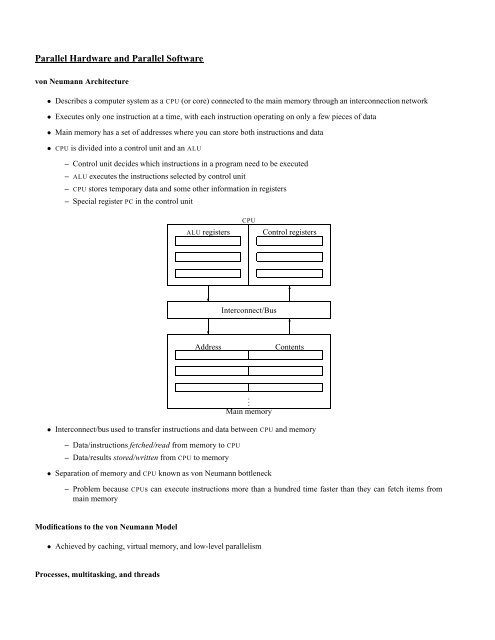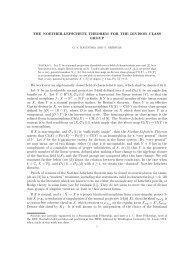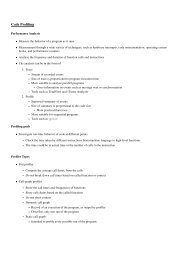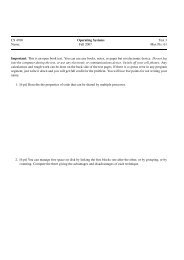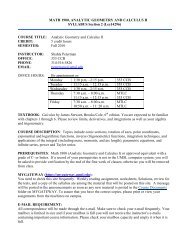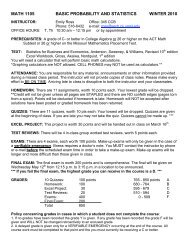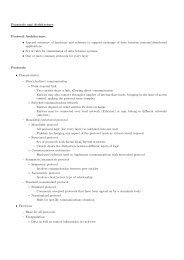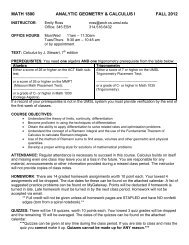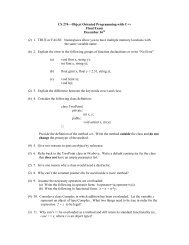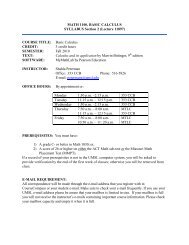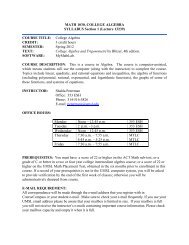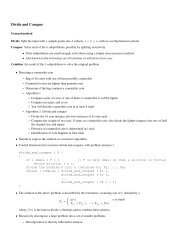Parallel Algorithm Design
Parallel Algorithm Design
Parallel Algorithm Design
Create successful ePaper yourself
Turn your PDF publications into a flip-book with our unique Google optimized e-Paper software.
<strong>Parallel</strong> Hardware and <strong>Parallel</strong> Softwarevon Neumann Architecture• Describes a computer system as a CPU (or core) connected to the main memory through an interconnection network• Executes only one instruction at a time, with each instruction operating on only a few pieces of data• Main memory has a set of addresses where you can store both instructions and data• CPU is divided into a control unit and an ALU– Control unit decides which instructions in a program need to be executed– ALU executes the instructions selected by control unit– CPU stores temporary data and some other information in registers– Special register PC in the control unitALU registersCPUControl registers✻❄Interconnect/Bus✻❄AddressContents.Main memory• Interconnect/bus used to transfer instructions and data between CPU and memory– Data/instructions fetched/read from memory to CPU– Data/results stored/written from CPU to memory• Separation of memory and CPU known as von Neumann bottleneck– Problem because CPUs can execute instructions more than a hundred time faster than they can fetch items frommain memoryModifications to the von Neumann Model• Achieved by caching, virtual memory, and low-level parallelismProcesses, multitasking, and threads
<strong>Parallel</strong> <strong>Algorithm</strong> <strong>Design</strong> 2• OS manages hardware and software resources; selects the processes to run and time to run them; allocates memory andother resources• Process as an abstraction of a running program; process control block• Multitasking – Concurrent execution of multiple processes; possibly on a single core using time slices or quanta• Threads – Lightweight processes– Process may block on a multitasking OS– Threading allows a programmer to divide the processes into parts that execute concurrently so that the blockage ofone part does not impede other parts– Faster to switch between threads than processes∗ They have their own activation record (program counter and call stack) to allow independent execution, butshare most of the other resources with other threads in the process– Threads are forked off a process and join the process upon termination<strong>Parallel</strong> <strong>Algorithm</strong> <strong>Design</strong>• <strong>Parallel</strong>izing a serial program– Divide the work among processes/threads– Ensure load balancing– Minimize communications and synchronization steps• Importance of abstraction and modularity• Task/channel model– A simple model for parallel programming– Facilitates the development of efficient parallel programs for distributed memory parallel computers– Defines a computation as a set of tasks connected by channelsTask/channel model• Represents parallel computation as a set of tasks that may interact with each other by sending messages through channels• <strong>Parallel</strong> computation• Task– Two or more tasks executing concurrently– Number of tasks may vary during program execution– Sequential program and its local storage, along with a collection of I/O ports∗ Effectively a virtual von Neumann machine∗ A set of in-ports and out-ports define its interface to the environment– Local storage contains instructions and data for the program– Sends local values to other tasks via output ports– May receive data values from other tasks via input ports– A task can perform four basic operations in addition to reading/writing local memory
<strong>Parallel</strong> <strong>Algorithm</strong> <strong>Design</strong> 3• Channel1. Send a message2. Receive a message3. Create tasks4. Terminate a task– Task may be mapped to physical PE; mapping does not affect the program semantics∗ Multiple tasks may be mapped to a single PE– Link between two tasks over which messages can be sent/received– Connects the in-port of one task to the out-port of another– May be created or deleted dynamically; references to channels (ports) can be included in messages to allow dynamicvariation in connectivity– Implemented as a message queue∗ Queue connects one task’s output port to the other task’s input port∗ Queue preserves the order in which messages are sent/received∗ A sender can place messages on the queue and a receiver can remove messages∗ The queue is said to be blocking if there are no messages available for removal– Blocked task∗ If a task tries to receive a value and none is available, the receiving task is blocked (synchronous task)∗ A sending task is never blocked (asynchronous task), even if the previous message sent by the same task hasnot yet been received· Send operation completes immediately• Local access of private data are easily distinguished from nonlocal data access that occurs over channel– Data in a task’s local memory are close; other data are remote– Local data access is much faster than nonlocal data access– Channel abstraction provides a mechanism to indicate that computation in one task requires data in another task toproceed; termed data dependency• Execution time of parallel algorithm– Period during which any task is active– Starting time is when all tasks simultaneously begin executing– End time is when the last task has stopped executingFoster’s design methodology• Four step process for designing parallel algorithms• Encourages development of scalable parallel algorithms by delaying machine-dependent considerations to later steps• Example: Laplace equation in 1D [Michael Heath]– Integral transform to represent and analyze linear systems using algebraic methods– Resolves a function or signal into its moments– Used for the analysis of linear time-invariant systems such as electrical circuits, harmonic oscillators, and opticaldevices– Often interpreted as a function from time domain into frequency domain
<strong>Parallel</strong> <strong>Algorithm</strong> <strong>Design</strong> 51. Partition– Decompose problem into primitive tasks, maximizing number of tasks that can execute concurrently∗ Use a data-centric approach or a computation-centric approach to decompose the problem– Data-centric approach/Domain decompositon∗ Divide data into pieces and then, determine how to associate communications with the data∗ Focus on largest/most frequently accessed data structure in program∗ Example: Consider a 3D matrix as the data structure targeted for decomposition· Partition matrix into a collection of 2D slices, giving a 1D collection of primitive tasks· Partition matrix into a collection of 1D slices, giving a 2D collection of primitive tasks· Consider each matrix element individually, giving a 3D collection of primitive tasks– Functional decomposition∗ Divide the computation into pieces and associate data items with individual computations∗ Image processing through pipelining– Each decomposition piece is called a primitive task∗ At least an order of magnitude more primitive tasks than number of processors in target parallel computer∗ Redundant computations and redundant data structure storage are minimized∗ Primitive tasks are roughly the same size∗ The number of tasks is an increasing function of problem size2. Communication– Determine communication pattern among primitive tasks, yielding task graph with primitive tasks as nodes andcommunication channels as edges– Overhead in a parallel algorithm (not required in sequential task)– Local communication∗ Task needs values from a small number of other tasks– Global communication∗ Significant number of primitive tasks must contribute data∗ Compute the sum of values held by primitive processes– Foster’s checklist – minimizing overhead
<strong>Parallel</strong> <strong>Algorithm</strong> <strong>Design</strong> 7∗ Workers request tasks from manager∗ Single manager becomes the bottleneck– Distributed task scheduling algorithms∗ Each processor maintains its own list of available tasks∗ Push strategy – Processors with many available tasks send some to neighboring processors∗ Pull strategy – Processors with no work ask neighboring processors for work∗ Difficult to know when all sub-tasks have completed– Foster’s checklist∗ <strong>Design</strong>s based on one task per processor and multiple tasks per processor have been considered∗ Both static and dynamic allocation of tasks to processors have been evaluated∗ If a dynamic allocation of tasks to processors has been chosen, the task allocator is not a bottleneck toperformance∗ If a static allocation of tasks to processors has been chosen, the ratio of tasks to processors is at least 10:1– Decision tree to choose a mapping strategy✟✟✟✟✟✟✟✙♠❍ ❍❍❍❍❍❍❥Static number of tasksDynamic number of tasks✠Roughly constantcomputation timeper task.Structuredcommunicationpattern.❅❅❅❘✠Computationtime per taskvaries by region.❅❅❅❘Unstructuredcommunicationpattern.✁❆ ✁ ❆❆❆❆❆❆❆❆❯✁✁✁✁✁✁✁☛Frequentcommunicationsbetween tasks.Many short-livedtasks. No intertaskcommunications.❄ ❄ ❄❄ ❄Agglomerate tasks tominimize communication.Create one task/processor.Cyclically map tasks toprocessors to balancecomputational load.Use a staticload balancingalgorithm.Use a dynamicload balancingalgorithm.Use a run-timetask-schedulingalgorithm.Boundary Value Problem• Thin rod of length 1 unit made of uniform material surrounded by a blanket of insulation• Temperature changes along the length of rod are result of heat transfer at the ends of rod and heat conduction along thelength of rod• Both ends of rod are exposed to an ice bath at temperature 0 ◦ C• Initial temperature at distance x from end of rod is 100 sin(πx)– The rod gradually cools over time• Temperature at any point of rod at any point in time modeled by a differential equation• Differential equation solved on computer by finite difference method to get an approximate solution as shown below
<strong>Parallel</strong> <strong>Algorithm</strong> <strong>Design</strong> 8• Finite difference method– Stores temperatures in a 2D matrix– Each row contains temperature distribution of the rod at some point– Rod divided into n sections of length h, n + 1 elements in each row– Time from 0 to T divided into m discrete entities of length k; m + 1 rows in the matrix– Initial temperature distribution along the length of rod represented by points in bottom row (known values)– Temperature at the ends of rod represented by left and right edges of grid (known values)– u i,j represents the temperature of rod at point i at time j– u i,j+1 is computed by• Partitioningwhere r = k/h 2– One data item per grid pointu i,j+1 = ru i−1,j + (1 − 2r)u i,j + ru i+1,j– Associate one primitive task with each grid point, leading to 2D domain decomposition• Communication– Draw channels between tasks to show the dependence– Task u i,j+1 requires values of u i−1,j , u i,j , and u i+1,j– Each task has three incoming channels and three outgoing channels• Agglomeration and mapping– Later tasks depend on earlier tasks; vertical paths from bottom to top– Agglomerate all tasks associated with each point in the rod– Task/channel graph reduced to a single row; much simpler∗ Linear array of tasks, each communicating solely with its neighbors– The number of tasks is static and the communication pattern between them is regular; each task performs the samecomputation∗ Create one task per processor∗ Agglomerate primitive tasks to balance computational workload and minimize communication
<strong>Parallel</strong> <strong>Algorithm</strong> <strong>Design</strong> 9• Analysis– Rod divided into n pieces of size h– Let χ represent the time needed to compute u i,j+1 , given u i−1,j , u i,j , and u i+1,j– Using single processor to update n − 1 interior values requires time (n − 1)χ– m time steps in the algorithm give the total execution time of sequential algorithm as m(n − 1)χ– Computation of parallel algorithm time∗ p processors; each processor responsible for equal size portion of rod’s elements∗ Computation time for each iteration: χ⌈(n − 1)/p⌉∗ Account for communication time as well∗ Each processor sends two values and receives two values from neighbors∗ Let λ be the time required to send/receive one value, giving communication time as 2λ∗ Send and receive may overlap in time (proceed concurrently)∗ Overall parallel algorithm execution time: χ⌈(n − 1)/p⌉ + 2λ∗ For m iterations, the time is: m(χ⌈(n − 1)/p⌉ + 2λ)Finding the maximum• The above solution to compute the temperature distribution is approximate• For each of the m points in the rod, difference between computed solution x and correct solution c is given by |(x − c)/c|• Modify the parallel algorithm to find the maximum error• Given a set of n values a 0 , a 1 , . . . , a n−1 and an associative binary operator ⊕, reduction is defined asa 0 ⊕ a 1 ⊕ a 2 ⊕ · · · ⊕ a n−1– Addition is an example of an associative binary operator– Finding the sum a 0 + a 1 + a 2 + · · · + a n−1 is an example of a reduction– Maximum and minimum of two numbers are also associative binary operators• Reduction requires n − 1 operations giving a time complexity of Θ(n) on a sequential computer– How quickly can we do it on a parallel machine?• Partitioning– n values in the list, divide into n pieces– Associate one task per piece– Goal is to find the sum of all n values• Communication– Set up communication channels between tasks– Channel from task A to task B allows B to compute the maximum of values held by two tasks– In one communication step, a task may send/receive one message– The task holding the maximum at the end of communication is called root task– Time λ to communicate a value to another task and time χ to find maximum of the two– Overall time: (n − 1)(λ + χ) – worse than sequential∗ Communication time is (n − 1)λ because root task must receive n − 1 messages
<strong>Parallel</strong> <strong>Algorithm</strong> <strong>Design</strong> 10– Create a tree-like topology; binary tree with 1, 2, 4, 8 nodes– Depth of tree given by k = log n– Overall time reduces to log n(λ + χ)• Agglomeration and mapping– Number of tasks is static, computation per task is trivial, communication pattern is regular– Agglomerate tasks to minimize communication∗ Assign n/p leaf tasks to each of the p processors• Analysis– χ: time needed to perform binary operation– λ: time needed to communicate a value from one task to another via channel– Divide n values evenly among p tasks; each task has at most ⌈n/p⌉ values– All tasks perform concurrently, time needed to compute subtotals is (⌈n/p⌉ − 1)χ– Reduction of p values distributed among p tasks performed in ⌈log p⌉ communication steps– Receiving process waits and performs reduction requiring time λ + χ– ⌈log p⌉ communication steps yield overall time for parallel program as(⌈n/p⌉ − 1)χ + ⌈log p⌉(λ + χ)The n-body problem• <strong>Parallel</strong>ize a sequential algorithm in which computation is performed on every pair of objects• Simulate the motion of n particles of varying mass in two dimensions due to gravitational pull• During each iteration, compute new position and velocity vector of each particle, given the position of all other particles– Complexity of Θ(n 2 ) for every iteration for n objects• Partitioning– One task per particle– To compute the location of the particle, the task must know the location of all other particles• Communication– gather operation∗ Global communication that takes a dataset distributed among a group of tasks and collects the items on a singletask∗ Concatenation of data items b, c, and d into the process containing a★✥♠a✧b ♠ c♠d ♠✻ ✻ ✻✦♠ b♠ c♠ d– all-gather operation∗ Similar to gather, except that at the end of communication, every task has a copy of the entire dataset
<strong>Parallel</strong> <strong>Algorithm</strong> <strong>Design</strong> 11∗ Useful in current context to update the location of every particle– Can be accomplished by putting a channel between every pair of tasks∗ During each communication step, each task sends its vector element to one other task∗ After n − 1 communication steps, each task has the positions of all other particles– Possible to improve communication performance to achieve above in logarithmic number of steps∗ Exchange one particle between every pair of processors∗ Exchange two particles between odd numbered processors and two between even numbered processors∗ Continue till all processors have all particles, with increasing number of particles at every step∗ Achieved by hypercube topology• Agglomeration and mapping– Generally, n ≫ p– Assume that n is a multiple of p– Agglomerate n/p particles per task– all-gather communication requires log p steps• Analysis∗ In the first step, length of messages is n/p∗ In the second step, length of messages is 2n/p– Derive an expression for execution time of the algorithm– λ is the latency to initiate communication– Bandwidth β represents the number of data items sent over a channel in one unit of time– Sending a message with n items now requires λ + n/β units of time– Communication time for each iterationlog∑p( )λ + 2i−1 nn(p − 1)= λ log p +βpβpi=1– Each task responsible for performing gravitational force computation for n/p list elements∗ Time needed for computation denoted by χ∗ Computation time for parallel algorithm is χ(n/p)– From above, expected parallel execution time per iteration isλ log p +n(p − 1)βp+ χ n pAdding data input• <strong>Parallel</strong> program inputs the original positions and velocity vectors for n particles– Assume that a single task responsible for all I/O (I/O task)– Open data file and read the position and velocities of n particles– Time needed to input or output n data elements: λ io + n/β io– Time to read the position (2 data items as x and y coordinates) and velocities of all n particles: λ io + 4n/β io• Communication– Break up input data into pieces to assign n/p elements to each task
<strong>Parallel</strong> <strong>Algorithm</strong> <strong>Design</strong> 12– scatter operation – reverse of gather– Send the correct n/p particles to each task in turn∗ p − 1 messages, each of length 4n/p∗ Time used: (p − 1)(λ + 4n/(pβ))∗ Not efficient because communication is not balanced among processors– Derive a scatter operation requiring log p communication steps∗ Send half the list to another task∗ Next, each process sends quarter list to previously inactive tasks∗ And keep on going by sending half of previous step∗ Time required for this islog∑pi=1(λ +– Data transmission time is identical for both algorithms• Analysis4n )4n(p − 1)2 i = λ log p +pββp∗ Task/channel model supports the concurrent transmission of messages from multiple tasks, as long as they usedifferent channels, and no two active channels have the same source or destination task– Derive an expression for the total expected execution time of the parallel n-body algorithm– I/O of positions and velocities of n particles is a completely sequential operation requiring time2(λ io + 4n/β io )– Scattering at the beginning and gathering particles at the end of the computation requires time()4n(p − 1)2 λ log p +βp– Each iteration of parallel algorithm requires an all-gather communication of particles’ position, requiring timeλ log p +2n(p − 1)βp– Each processor performs its share of computation, requiring time⌈ ⌉ nχ (n − 1)p– If algorithm executes for m iterations, overall execution time of parallel computation is about(2 λ io + 4n ) () (⌈ ⌉ )4n(p − 1)2n(p − 1) n+ 2 λ log p + + m λ log p + + χ (n − 1)β io βpβp pSieve of EratosthenesSequential algorithmCreate a Boolean array from 1 to nMark all values as truek = 2while kˆ2 < nChange all multiples of k between kˆ2 and n to falseFind smallest index p > k that contains truek = pThe indices that are true represent prime numbers
<strong>Parallel</strong> <strong>Algorithm</strong> <strong>Design</strong> 13• Not practical to find large primes• Complexity of algorithm is Θ(n ln ln n); n is exponential in number of digitsSource of parallelism• Domain decomposition– <strong>Algorithm</strong> involves marking the elements of the array representing integers– Break the array into n − 1 elements– Associate a primitive task with each of these elements• Key parallel task– Change all multiples of k between k 2 and n to falsefor ( j = k * k; j
<strong>Parallel</strong> <strong>Algorithm</strong> <strong>Design</strong> 14· We cannot give every process 103 elements because the array is not that large∗ Give first p − 1 processes ⌈n/p⌉ processes and give the leftover to process p· There may be no elements left for process p· Complicates logic of programs if processes exchange values· Leads to less efficient utilization of communication network– Balance workload by assigning either ⌈n/p⌉ or ⌊n/p⌋ elements to each process– Questions1. What is the range of elements controlled by a given process?2. Which process controls a given element?– Method 1∗ Compute r = n%p∗ If r == 0 every process gets a block of size n/p∗ Otherwise· First r blocks have size ⌈n/p⌉· Remaining p − r blocks have size ⌊n/p⌋∗ First element controlled by process i: i⌊n/p⌋ + min(i, r)∗ Last element controlled by process i: (i + 1)⌊n/p⌋ + min(i, r) − 1∗ Process controlling element j:(⌊maxj⌊n/p⌋ + 1⌋ ⌊ ⌋) j − r,⌊n/p⌋∗ The expressions for the first and last element are easy to compute and can be saved for each process at thebeginning of algorithm∗ The expression to find the controlling process for element j is more complex and needs to be computed on thefly (not good)– Method 2∗ Scatter larger blocks among processes∗ First element controlled by process i: ⌊in/p⌋∗ Last element controlled by process i: ⌊(i + 1)n/p⌋ − 1∗ Process controlling an element j ⌊ ⌋p(j + 1) − 1n– Distributing 14 elements among four tasksGroupedDistributedTask 0 Task 1 Task 2 Task 3– Method 2 is superior because it requires fewer operations to perform the three common block management operations∗ Even better as integer division automatically gives floor• Block decomposition macros– Applicable to any parallel program– Define three C macros to be used for block limits and ownership#define BLOCK_LOW(id,p,n) ((id)*(n)/(p))#define BLOCK_HIGH(id,p,n) (BLOCK_LOW((id)+1,(p),(n)) - 1 )#define BLOCK_SIZE(id,p,n) (BLOCK_HIGH((id),(p),(n)) - BLOCK_LOW((id),(p),(n)) + 1)#define BLOCK_OWNER(index,p,n) (((p)*((index)+1)-1)/(n))– BLOCK_LOW gives the first index controlled by the process
<strong>Parallel</strong> <strong>Algorithm</strong> <strong>Design</strong> 15– BLOCK_HIGH gives the last index controlled by the process– BLOCK_SIZE gives the number of elements controlled by the process– BLOCK_OWNER evaluates to the rank of the process controlling the element of the array• Local index vs global index– Limit (localize) the indices within overall (global) arrayTask 0 Task 1 Task 2Global index 0 1 2 3 4 5 6 7 8 9 10Local index 0 1 2 0 1 2 3 0 1 2 3∗ Local index varies from 0 to 2 or 3, depending on process∗ Global index varies from 0 to 10∗ Sequential code uses global index; we need to substitute to local index when working with parallel code– Sequential programfor ( i = 0; i < n; i++ ){...}– <strong>Parallel</strong> programsize = BLOCK_SIZE(id,p,n);for ( i = 0; i < size; i++ ){gi = i + BLOCK_LOW(id,p,n);...}• Ramifications of block decomposition– Largest prime used to sieve integers up to n is √ n– First process has ⌊n/p⌋ elements// Global index; replaces i∗ It has all sieving primes if p < √ n∗ Reasonable assumption since n is expected to be in millions– Fast marking∗ Block decomposition allows same marking as sequential algorithminstead offor all j in blockp[j] = ( j % k ) != 0;∗ This gives about (n/p)/k assignment statementsj, j + k, j + 2k, j + 3k, . . .– Effectively, block decomposition results in fewer computational steps and fewer communications stepsDeveloping the parallel algorithm• Translate each step in sequential algorithm to its equivalent in parallel1. Create a Boolean array from 1 to nMark all values as true– Each process can create and initialize its own share of the array– The size of the array is either ⌈n/p⌉ or ⌊n/p⌋2. k = 2– Each process does this as a trivial assignment
<strong>Parallel</strong> <strong>Algorithm</strong> <strong>Design</strong> 163. In the while loop, each process marks its share of the array(a) Change all multiples of k between kˆ2 and n to false– Each process marks the multiples of k within its block between k 2 and n– We need to determine the location of first multiple of k within the block(b) Find smallest index p > k that contains true– Always done by process 0(c) Broadcast the value of k to all processes• Function MPI_Bcast– Broadcast a message from the process with rank root to all other processes of the communicatorint MPI_Bcast ( void * buffer, int count, MPI_Datatype datatype, int root,MPI_Comm comm );buffer Starting address of the array of data items to broadcastcount Number of data items in the arraydatatype Data type of each item (uniform since it is an array); defined by an MPI constantroot Rank of broadcast root – the process that initiates the broadcastcomm Communicator; group of processes participating in this communication function– In parallel sieve, process 0 needs to broadcast a single integer k to all other processesMPI_Bcast ( &k, 1, MPI_INT, 0, MPI_COMM_WORLD );– Processes can trivially determine the number of prime numbers found within their own arrays at the end of thewhile loop∗ The values can be accumulated into a grand total by using MPI_ReduceAnalysis of parallel sieve algorithm• Time to mark each cell as multiple of prime is given by χ– Includes the time to∗ Change the value to false∗ Increment loop index∗ Testing for termination• Sequential algorithm execution time: Θ(n ln ln n) or with known χ, χn ln ln n• Cost of each broadcast: λ⌈log p⌉– λ is message latency– Only a single value is broadcast per iteration• Number of broadcasts:√ nln √ n– Based on number of primes between 2 and n given bynln √ n• Expected execution timeχ(n ln ln n)p+√ nln √ λ⌈log p⌉nThe codeBenchmarking
<strong>Parallel</strong> <strong>Algorithm</strong> <strong>Design</strong> 17• Determine the value of χ by running a sequential implementation on a single processor of the cluster• Determine λ by performing a series of broadcasts on 2, . . . , 10 processors• Plug in the values and find performance gainImprovements• Delete even integers– Change sieve algorithm to represent only odd integers∗ Half the storage∗ Double the speed• Eliminate broadcast– Broadcast step to give starting value of k is repeated √ nln √ n times– Replicate computation of primes up to √ n– Useful if √ nln √ n λ⌈log p⌉ > χ√ n ln ln √ nλ⌈log p⌉⇒ln √ > χ ln ln √ nn⇒ λ > χ ln(ln √ n+ √ n)⌈log p⌉– Expected time complexity now is• Reorganize loops( n ln ln nχ + √ n ln ln √ )n + λ⌈log p⌉2p– Each process marking widely dispersed elements of a very large array leads to poor cache hit rate– Improve cache hit rate by exchanging inner and outer loops• Benchmarking


